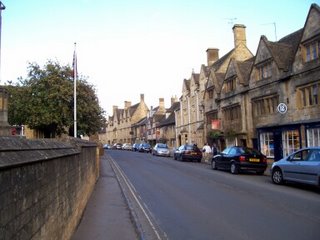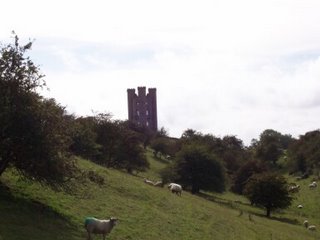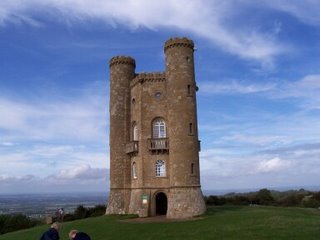
 Despite a 20% chance of rain and mostly cloudy skies, we set off this morning for the northern Cotswold village of Chipping Campden and a short walk on the Cotswold Way to Broadway Tower. (Along the walk, there was much discussion of what "20% chance of rain" means. Does it mean that it will rain 20% of the time?) Chipping Campden is known for its particularly fine High Street. The honey-colored limestone of the buildings on the High Street is typical of villages in the Cotswolds. The village also has a very fine church built of Cotswold stone, the Church of St. James, which is full of remarkable treasures, including the early fifteenth-century brass of William Grevel, "the flower of the wool merchants of all England." In the late middle ages, Chipping Campden's wealth came from the wool of the Cotswolds' famous sheep. Now, most of its wealth comes from tourism. Even on a dull, damp late September day, there were large groups of Japanese tourists strolling up and down the High Street, looking into antique shops and tea shops and quaint boutiques.
Despite a 20% chance of rain and mostly cloudy skies, we set off this morning for the northern Cotswold village of Chipping Campden and a short walk on the Cotswold Way to Broadway Tower. (Along the walk, there was much discussion of what "20% chance of rain" means. Does it mean that it will rain 20% of the time?) Chipping Campden is known for its particularly fine High Street. The honey-colored limestone of the buildings on the High Street is typical of villages in the Cotswolds. The village also has a very fine church built of Cotswold stone, the Church of St. James, which is full of remarkable treasures, including the early fifteenth-century brass of William Grevel, "the flower of the wool merchants of all England." In the late middle ages, Chipping Campden's wealth came from the wool of the Cotswolds' famous sheep. Now, most of its wealth comes from tourism. Even on a dull, damp late September day, there were large groups of Japanese tourists strolling up and down the High Street, looking into antique shops and tea shops and quaint boutiques.

 Our walk took us south from Chipping Campden along the Cotswolds Way, a long-distance footpath that runs a hundred miles from Chipping Campden in the north to Bath in the south. We only walked as far as Broadway Tower, a Gothic revival "folly" built in 1797 by the sixth Earl of Coventry, for no other reason than that it seemed a shame to have such a wonderful exposed hill without a tower on top. In the nineteenth century, Broadway Tower was a favorite retreat for the pre-Raphaelites, especially Edward Burne-Jones and William Morris. From the top, even on a cloudy day, we could see the Malvern Hills and, in the far distance, the gray outline of the Black Mountains of Wales. There was a brisk wind blowing on the top of the tower, and it was hard to imagine William Morris bathing up there, as his daughter May (who also loved staying at Broadway Tower) reports him to have done. It was worth the £10 family admission price to Broadway Tower to hear Will (whose standard for walking in England was set in the Lake District) admit that this was a good walk.
Our walk took us south from Chipping Campden along the Cotswolds Way, a long-distance footpath that runs a hundred miles from Chipping Campden in the north to Bath in the south. We only walked as far as Broadway Tower, a Gothic revival "folly" built in 1797 by the sixth Earl of Coventry, for no other reason than that it seemed a shame to have such a wonderful exposed hill without a tower on top. In the nineteenth century, Broadway Tower was a favorite retreat for the pre-Raphaelites, especially Edward Burne-Jones and William Morris. From the top, even on a cloudy day, we could see the Malvern Hills and, in the far distance, the gray outline of the Black Mountains of Wales. There was a brisk wind blowing on the top of the tower, and it was hard to imagine William Morris bathing up there, as his daughter May (who also loved staying at Broadway Tower) reports him to have done. It was worth the £10 family admission price to Broadway Tower to hear Will (whose standard for walking in England was set in the Lake District) admit that this was a good walk. Dante Gabriel Rossetti, May Morris
Dante Gabriel Rossetti, May MorrisAs we walked back to the car, rain started to fall out of a sunny sky and a rainbow appeared directly over Chipping Campden, as if its mellow limestone buildings were the pot of gold. Like all good walks, this one ended at a pub—the Eight Bells, which claims a history going back to the fourteenth-century—with a pint of Butty Bach from the Wye Valley Brewery.


No comments:
Post a Comment